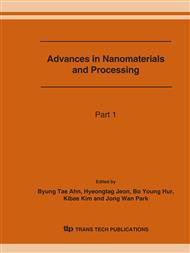p.1449
p.1453
p.1457
p.1461
p.1465
p.1469
p.1473
p.1477
p.1481
A Characteristics Study of FeAlCr Intermetallic Compound Manufactured by Osprey Forming Process
Abstract:
The FeAlCr intermetallic compound has a high possibility to be used as the material of the aerospace industry, in the internal combustion engine, in the heat exchanger and as the material of next-generation heat resistant material due to the low density, the excellence in oxidation resistance and corrosion and the high melting point. The study fixed the Cr content of 6% in FeAl alloy to improve the Ductile in the room temperature and added MO and Hf to improve the Grain Refinement and the mechanical properties. This alloy was manufactured by Osprey Forming Process to improve the ductile and the workability in room temperature and to try to get the low production cost as well. The microstructure and the Fracture phenomenon of specimens after homogenizing(1,000 °C , 168hour) and phase stabilizing heat treatment(500°C, 120hour) was observed by SEM, EDS, XRD, Hardness and Compression. The microstructure of FeAlCr intermetallic compound was changed from the coarse equixed structure to the minute equixed one because of the addition of Mo and Hf. The rates of hardness and yield strength of FeAlCr intermetallic compound were increased after Mo and Hf had been added in it.
Info:
Periodical:
Pages:
1465-1468
Citation:
Online since:
June 2007
Authors:
Price:
Сopyright:
© 2007 Trans Tech Publications Ltd. All Rights Reserved
Share:
Citation:


